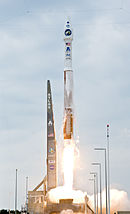Atlas III
| Rodzina rakiet nośnych Atlas | |
 Start rakiety Atlas III z satelitą Eutelsat W4 | |
| Producent | |
|---|---|
| Data pierwszego startu | 24 maja 2000 |
| Data ostatniego startu | 3 lutego 2005 |
| Statystyki | |
| Wszystkie starty | 6 |
| Udane starty | 6 (100%) |
| Nieudane starty | 0 |
| Zdolność wynoszenia | 8640-10218 kg na LEO |
| Wymiary | |
| Długość | 52,8 m |
| Średnica | 3,05 m |
| Masa całkowita | 214 338 kg |
| Stopnie rakiety | |
| Stopień 1. | |
| Stopień 2. | |
Atlas III – amerykańska rakieta nośna serii Atlas, pierwsza nie wykorzystująca technologii 1,5-stopniowej od czasu rakiety Atlas A. Jako napęd pierwszego członu po raz pierwszy wykorzystała rosyjski silnik RD-180, drugim członem był zmodyfikowany człon Centaur, w wersji z jednym[1] bądź dwoma[2] silnikami RL-10.
Starty
- 24 maja 2000, 23:10 GMT; s/n AC-201; miejsce startu: Cape Canaveral Air Force Station (SLC-36B), USA
Ładunek: Eutelsat W4; Uwagi: start udany - 21 lutego 2002, 12:43 GMT; s/n AC-204; miejsce startu: Cape Canaveral Air Force Station (SLC-36B), USA
Ładunek: Echostar 7; Uwagi: start udany - 12 kwietnia 2003, 00:47 GMT; s/n AC-205; miejsce startu: Cape Canaveral Air Force Station (SLC-36B), USA
Ładunek: Asia-Sat 4; Uwagi: start udany - 18 grudnia 2003, 02:30 GMT; s/n AC-203; miejsce startu: Cape Canaveral Air Force Station (SLC-36B), USA
Ładunek: USA-174; Uwagi: start udany - 13 marca 2004, 05:40 GMT; s/n AC-202; miejsce startu: Cape Canaveral Air Force Station (SLC-36B), USA
Ładunek: MBSAT-1; Uwagi: start udany - 3 lutego 2005, 07:41 GMT; s/n AC-206; miejsce startu: Cape Canaveral Air Force Station (SLC-36B), USA
Ładunek: USA-181 (NROL-23); Uwagi: start udany
GX
Konsorcjum Galaxy Express Corporation (zawiązane pomiędzy JAXA, Lockheed Martin (później United Launch Alliance), IHI Corporation i kilkoma japońskimi firmami) planowało stworzenie rakiety o nazwie GX. Początkowo miała ona wykorzystywać pierwszy człon Atlasa III (zrezygnowano z niego na rzecz członu Common Core Booster z rakiety Atlas V). Projekt porzucono w 2009[3].
Przypisy
- ↑ Mark Wade: Atlas 3A (ang.). W: Encyclopedia Astronautica [on-line]. [dostęp 2017-06-15].
- ↑ Mark Wade: Atlas 3B (ang.). W: Encyclopedia Astronautica [on-line]. [dostęp 2017-06-15].
- ↑ Japan scraps GX rocket development project. iStockAnalyst.com, 2009-12-16. [zarchiwizowane z tego adresu (2016-03-26)].
Media użyte na tej stronie
Atlas IIIA Centaur on its first launch (May 24, 2000) - An Atlas III space lift vehicle (AC-201) made its debut on May 24, 2000, in a dramatic liftoff powered by the new Russian RD-180 engine. The liftoff occurred at 7:10 p.m. Eastern Daylight Time, followed by successful separation of the W4 spacecraft and insertion into geosynchronous transfer orbit just under 29 minutes later. The AC-201 flight marks the first Russian rocket engine to be provided by Pratt & Whitney and is the first Russian rocket engine to power an American launch vehicle. A P&W upper stage engine, the RL10 (RL10A-4-1B model), powered the Atlas first single-engine Centaur configuration.
Trailing a column of fire, the Atlas V(401) carrying NASA's Lunar Reconnaissance Orbiter, or LRO, and NASA's Lunar Crater Observation and Sensing Satellite, known as LCROSS, hurtles off Launch Complex 41 at Cape Canaveral Air Force Station in Florida. LRO and LCROSS are the first missions in NASA's plan to return humans to the moon and begin establishing a lunar outpost by 2020. The LRO also includes seven instruments that will help NASA characterize the moon's surface: DIVINER, LAMP, LEND, LOLA , CRATER, Mini-RF and LROC. Launch was on-time at 21:32 UTC.
Atlas 3F prior to failed launch attempt






